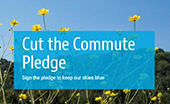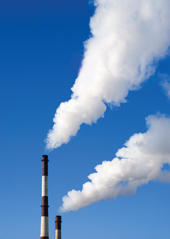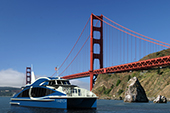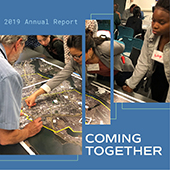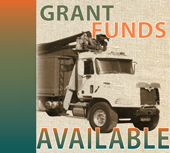|
|

|
|
|
|
August 2020 l Volume 2020-3
|
|
|
|
|
|
|
In this issue you'll find articles about the Air District Board's passage of a resolution in support of racial justice, the Cut the Commute pledge for employers and the new remote work clearinghouse toolkit. Other articles cover the Air District's Facility Risk Reduction program, the agency's first-ever loan guarantee to a zero-emission ferry project, the Air District's 2019 Annual Report, upcoming Diesel Free by '33 webinars and the agency's participation in a lawsuit challenging federal rollbacks to the clean vehicle standards. A summary of current grant opportunities is also included.
|
|
|
|
|
|
|
|
|
|
|
|
|
|
Air District Board Adopts Resolution in Support of Racial Justice
|
|
| | |
|
On June 17, the Air District’s Board of Directors voted to adopt a resolution condemning racism and injustice and affirming the agency’s commitment to diversity, equity, access and inclusion. This resolution supporting racial justice formally recognizes the Air District’s commitment to advance the cause of diversity and equity in its policies, programs and practices. Racial discrimination is historically ingrained in American systems of government and every level of government has a role to play in breaking down barriers that reduce social, economic and political opportunities for people of color.
A full copy of the resolution is available on the Air District’s Adopted Resolutions web page.
|
|
|
|
|
|
|
|
|
|
|
|
Air District Asks Employers to Expand Remote Work Options
|
|
| | |
|
The Air District is encouraging Bay Area employers to sign the Cut the Commute Pledge to extend remote work options for employees and maintain air quality progress in the region even after shelter-in-place orders are eased. The clean air we have been experiencing since the Bay Area was ordered to shelter in place on March 16 is due, in part, to the accompanying dramatic reduction in vehicle traffic on our roads. Transportation is the number one source of air pollution in the region and taking cars off the road significantly improves the quality of our air. Allowing employees to work from home can be a big part of the solution to keeping our skies blue.
Teleworking benefits also include:
- Reduced traffic congestion
- Cost savings for employers and employees
- Improved employee recruitment and retention
- Improved work-life balance
- Increased ability to effectively continue business as a part of a disaster recovery or emergency plan
By signing the Cut the Commute Pledge, employers vow to extend remote work options by at least 25 percent for employees whose work requirements allow for that flexibility. By signing, employers also commit to include a formalized remote work policy as a component of their employee benefits package, which will improve air quality and quality of life for all Bay Area residents.
|
|
|
|
|
|
|
|
|
|
|
|
Air District Publishes Remote Work Policy Clearinghouse Toolkit
|
|
| | |
|
The Air District's Remote Work Policy Clearinghouse web page includes a complete remote work toolkit, featuring resources and guidance, model teleworking agreements and information on equity considerations and ergonomics. Remote work allows employees that have the flexibility to do so to work offsite, usually from their homes. Extending remote work options for employees after the COVID-19 shutdown orders are lifted can improve traffic congestion, help maintain our air quality progress, reduce employer and employee costs and mitigate climate impacts.
The Air District's Remote Work Policy Clearinghouse web page includes information on the mobility, air quality and health benefits of remote work for elected officials, private businesses and public agencies.
Offering a formalized remote work policy can be mutually beneficial to both employees and employers. These benefits include:
- Cleaner air and reduced climate impacts
- Reduced traffic congestion
- Money and time saved that would be spent in traffic
- Improved employee recruitment, retention, and productivity
- Money saved on commercial real estate and parking facilities
- Enhanced employee wellness and work-life balance
- Enhanced opportunities for persons with disabilities
- Resiliency - provides a blueprint to continue business during a crisis
|
|
|
|
|
|
|
|
|
|
|
|
First of Its Kind Rule Reduces Toxic Air Pollution in Bay Area Communities
|
|
| | |
|
In order to comply with the most stringent toxic air pollution regulation in the nation, local industries are taking early action to further reduce their health impacts on local residents. The Air District’s Regulation 11-18 imposes stricter toxic air pollution standards on existing facilities and requires them to take necessary measures to reduce health and cancer risks in surrounding communities.
The Air District assesses local health risk by using models that incorporate cutting-edge research from the State of California’s Office of Environmental Health Hazard Assessment on the impacts of toxic air pollution on people living and working near facilities.
The adoption of Regulation 11-18 has already resulted in reduced emissions of toxic air contaminants at facilities through preemptive risk reduction projects, including emissions inventory correction and validation, process changes and abatement measures.
By the fall of this year, the Air District will initiate health risk assessments for the majority of facilities that show potential for the most toxic air pollution impacts, with the remaining facilities scheduled to be completed in the subsequent 12 months.
The Air District will seek public comment on these major facility health risk assessments when they are released in draft form. The health risk assessment reports and staff contact information are available on the Air District’s Rule 11-18 Risk Reduction Facilities web page.
The public will have 45 days to provide comments, which can be made online, emailed to the Air District contact or submitted in writing. The Air District will respond to all comments before finalizing the report.
The final health risk assessment report will then be posted to the table on the Risk Reduction Facilities web page. If a facility’s health risk exceeds the risk action level in Rule 11-18, it will be required to submit a risk reduction plan within six months of the final health risk assessment decision. The Air District will review and approve - or send back for revision - these risk reduction plans, which outline actions the facility will take to reduce emissions below the trigger levels.
The public will also be given an opportunity to comment on the risk reduction plans before they are finalized.
|
|
|
|
|
|
|
|
|
|
|
|
Air District Funds its First Loan Guarantee for Zero-Emission Ferry
|
|
| | |
|
The Air District has awarded its first ever loan guarantee to SWITCH Maritime, an impact investment company building the first fleet of zero-emissions vessels in North America. SWITCH’s flagship vessel is a first-of-its-kind, 84-passenger, fuel cell electric “e-ferry” that is currently in the final phases of construction and will commence operation on a route between Oakland and San Francisco later this year. This project will have the added benefits of creating work for 63 people while reducing greenhouse gas emissions and diesel particulate matter for impacted communities around the Port of Oakland.
This loan guarantee is the first project under the Air District’s Climate Tech Finance program, which seeks to reduce greenhouse gases by accelerating emerging climate technologies. In partnership with the California Infrastructure Economic Development Bank and the Northern California Financial Development Corporation, the Climate Tech Finance team led a technology qualification and greenhouse gas analysis that deemed SWITCH eligible for a $2.5 million loan guarantee. This loan guarantee supported SWITCH in securing a $5 million loan with a commercial bank.
The core value of Climate Tech Finance is to support innovative climate projects, and the Air District’s greenhouse gas analysis ensures that new technologies will reduce short- and long-term greenhouse gas emissions. The e-ferry's electric propulsion system and fuel cell powertrain are 100 percent zero emissions, thereby completely preventing the greenhouse gas emissions associated with conventional, diesel-fueled vessels. Estimates show that operation of this zero-emission ferry in the San Francisco Bay could avoid roughly 1,190 metric tons of carbon dioxide equivalent emissions per year for the next five years or more.
|
|
|
|
|
|
|
|
|
|
|
|
Coming Together: 2019 Annual Report Highlights Community Partnerships
|
|
| | |
|
Over the past year, the Air District has expanded our work with some of the communities most impacted by air pollution. Our 2019 annual report highlights this important community work and other innovative and exciting projects that improve air quality and cool the climate. The report covers our community partnerships, new advancements in regulatory work and incentive programs through a dynamic new website that utilizes animation and original video content to tell the story of the Air District’s accomplishments.
From the West Oakland Community Action Plan and the Richmond-San Pablo Community Air Monitoring Plan, to the Clean Cars for All Program and extensive grants programs, the Air District is coming together with communities for a healthier Bay Area for all.
Check out the Air District's interactive online 2019 annual report.
|
|
|
|
|
|
|
|
|
|
|
|
Air District to Host Webinars on Diesel Reduction Funding
|
|
| | |
|
The Air District will be hosting two webinars in August on potential funding options to help companies and organizations transition away from diesel vehicles and equipment. The first webinar, entitled Funding to Replace Diesel: Fleets and Equipment, will be held on August 5. In this webinar, presenters from the Air District, the State of California and PG&E will provide an overview of funding options for the purchase or replacement of heavy-duty vehicles, equipment and charging infrastructure.
The second webinar – Funding to Replace Diesel: Backup Generators – will be on August 19. In this webinar, presenters will provide an overview of funding options for purchasing or replacing non-diesel back-up generators.
Webinars will be hosted on Zoom and will include time for Q&A.
Webinar Details
Funding to Replace Diesel: Fleets and Equipment
Wednesday, August 5, 10:00-11:30 AM (Register)
Funding to Replace Diesel: Backup Generators
Wednesday, August 19, 10:00-11:30 AM (Register)
Future Webinars
Why Replacing Diesel is a Public Health Priority
Week of August 30 – Date and time to be announced
Visit the Air District's Workshops and Events web page for more information.
|
|
|
|
|
|
|
|
|
|
|
|
Air District Joins Lawsuit Challenging Trump Administration Rollbacks to Clean Vehicle Standards
|
|
| | |
|
|
|
|
|
|
|
|
Air District Offers Millions in Grants
|
|
| | |
|
The Air District administers a number of grant funding programs that offer incentives for clean air projects. Grant Funding Programs Open Now and Coming Soon
Grant programs for Bay Area businesses and public agencies:
Equipment/Engine Replacement/Repower or Conversion, and Infrastructure
- Carl Moyer Program - $12 million is available for eligible projects that upgrade or replace on-road vehicles, school buses, transit buses, off-road and agricultural equipment, marine equipment, and locomotives. Applications are being accepted on a first-come, first-served basis until all funds are awarded. www.baaqmd.gov/moyer
- Community Health Protection Grant Program - Funding is available for eligible projects that reduce toxic air emissions and ozone-forming pollutants from mobile and stationary sources by replacing old, high-polluting vehicles and equipment. Priority is given to projects in the AB 617-identified communities of West Oakland, Richmond-San Pablo, East Oakland/San Leandro, Eastern San Francisco, Pittsburg-Bay Point area, San Jose, Tri-Valley area, and Vallejo. Community input will play an important role in guiding the Air District’s outreach and process for identifying priority projects. Applications are being accepted on a first-come, first-served basis until all funds are awarded. www.baaqmd.gov/ab617grants
- Lower-Emission School Bus Program - Funding is available for public school districts, Joint Powers Authorities (JPAs), and contracted fleets in the Bay Area for bus replacements, engine repowers or electric conversions, natural gas tank replacements, and electric charging and alternative fueling infrastructure projects. Applications are being accepted on a first-come, first served basis until all funds are awarded. www.baaqmd.gov/lesbp
- Volkswagen NOx Mitigation Program - Zero-Emission Transit and Shuttle Buses - Up to $32.5 million is available to owners of bus fleets that operate in California to support early adoption of zero-emission bus technologies to reduce harmful exposure for the state’s most sensitive populations. This solicitation is open and accepting applications for transit and shuttle buses on a first-come, first-served basis. http://vwbusmoney.valleyair.org/
- Volkswagen NOx Mitigation Program - Zero-Emission Freight and Marine – $35 million is available statewide for funding airport ground-support equipment and cargo handling equipment replacement, marine vessel engine repower, and shore power projects. The solicitation is competitive and will close on August 31, 2020. https://www.californiavwtrust.org/zero-freight-marine/
- COMING SOON! Other project categories funded by Volkswagen NOx Mitigation Fund - Solicitations for zero-emission Class 8 freight and port drayage trucks, and light-duty electric-vehicle infrastructure projects are anticipated to open mid- to late 2020. Visit https://www.californiavwtrust.org/ to learn more about these opportunities and sign up for email alerts.
Vehicle Trip Reduction Grant Program - up to $4M
-
Clean Mobility Projects -Funding is available to public agencies to co-fund trip reduction projects in the Bay Area that have been awarded either a Clean Mobility Project Voucher under the Clean Mobility Options Voucher Pilot Program or an Implementation Grant under the Sustainable Transportation Equity Project.
- COMING SOON! Bicycle Facilities - This program is scheduled to open by September 2020. Public agencies are eligible to apply for grants for projects that install new bikeways and bicycle parking. Applications will be accepted on a first-come, first-served basis, until all funds are awarded. www.baaqmd.gov/tripreduction
Loan Guarantees and Low-Interest Financing
- Climate Tech Finance Program - Subsidized financing is available to help Bay Area facilities adopt emerging technologies that reduce greenhouse gas emissions. Public facilities can apply for loans ranging from $500,000 to $30 million, up to 30-year terms. Small businesses can apply for loan guarantees up to 90%. This program is open and accepting applications now. www.baaqmd.gov/ctf
Grant programs for Bay Area residents:
- Light-Duty Vehicle Replacement - The Clean Cars for All Program is open to all income-qualified Bay Area residents. The program provides varying incentives to retire older, high-polluting vehicles and replace them with newer, cleaner vehicles or with alternative transportation options (e.g. Clipper card). Eligible vehicles for purchase or lease include hybrid electric, plug-in hybrid, or electric vehicles. This program is open and accepting applications now. www.baaqmd.gov/cleancarsforall
- Passenger Car and Light-Duty Truck Retirement - The Vehicle Buy Back Program pays Bay Area residents $1,200 per vehicle to turn in their operable, registered, model year 1997 and older passenger car or light-duty truck for scrapping. www.baaqmd.gov/vbb
|
|
|
|
|
|
|
|
|
|
|



